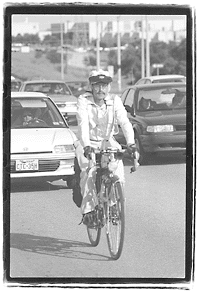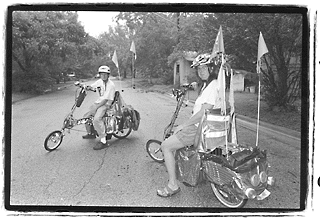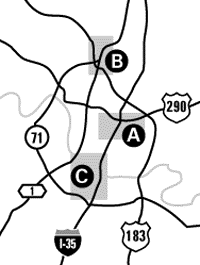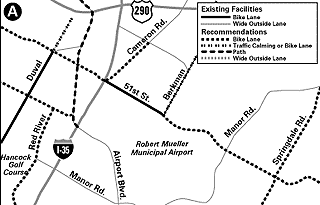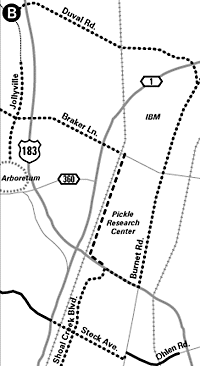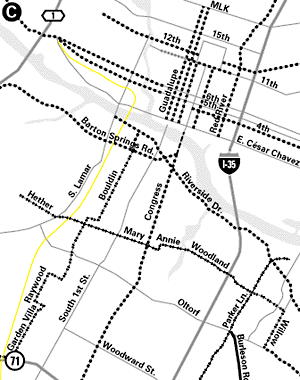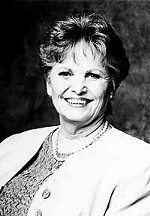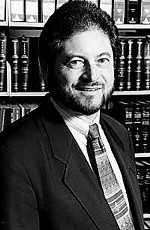Breaking Away
Austin's Newest Bike Plan May Finally Pull Ahead
By Kevin Fullerton, Fri., Oct. 17, 1997
|
|
Eden wheels down Loop 360 and meets a swift lane of merging MoPac traffic on his right. He signals and plunges into the flow. This reporter, however, is unnerved. I halt, forcing the line of traffic to stop while I enter the lane. One driver bumps his horn, irritated. Eden is sympathetic. "The way you learn is by forcing your way out into the middle of traffic and making a bunch of mistakes," says the veteran biker.
In recent years, traffic engineers and city planners have recognized that bicycle commuting is integral to solving urban congestion and pollution, but for now, cyclists are stuck with a transportation infrastructure built almost exclusively for motorists. Experienced riders like Eden have adapted, but the host of intimidating barriers -- busy intersections, high-speed traffic, and roads without bike lanes -- are not inviting to potential new bike commuters.
As Eden rolls east into downtown, he points out numerous examples that show how traffic planners have belittled or ignored cyclists' needs. Bike lanes are discontinuous, poorly marked, and frequently blocked with parked cars. Traffic lights do not change for bicycles, or change from green to red too quickly at intersections where cyclists are pedaling uphill. Crossing the bridge at South First, Eden describes how the original construction did not even leave cuts in the curb to allow bicyclists to get on and off, and how the cuts that were added now dump bikes into a blind curve. Finally, halting at a downtown intersection atop a hill on San Jacinto, Eden gestures at three blocks of freshly painted bike lane on one side of the street.
"That's all we've [bicyclists] gotten in five years," he says, referring to the interval since the city commissioned a task force that ultimately led to the establishment of the city's bicycle program.
|
|
Like Eden, former Vietnam fighter pilot Salazar can hold his own in Austin's busy thoroughfares, but only by employing what he calls "selective disobedience" of traffic laws to cross intersections.
Austin cyclists often find themselves trapped in zones bordered by major arteries, adds Mike Librik, a recumbent bicycle dealer who voluntarily produced a bicycle route map for the UT Health Promotions Office (see centerfold). Tapping his computer screen, Librik indicates blue arrows that mark signaled intersections. "The question that comes up is: `How am I going to get across this high-density corridor?'" says Librik. "We've built these really inhuman places, but people are usually insulated from them in their cars. When they have to get out in them, it's no wonder why nobody wants to bike around."
Bicycle projects have been in place in Austin since the early Seventies, says Rick Waring, coordinator of the Austin Bicycle Program (ABP), but the planning was never consistent or continuous, and thus never promoted bicycles as serious forms of travel. The creation of the ABP in '94, and the subsequent drafting of the Austin Bicycle Plan, indicate that the city is willing to move steadily forward with bicycle improvements. But the question is: How quickly?
Funding Eden's Garden
|
|
The good news is, the dollars are available through federal transportation funds. Through the 1991 Intermodal Surface Transportation Efficiency Act (ISTEA), the federal government will help pay for new transportation projects that include bicycle and pedestrian access. So far, says Waring, $4-5 million has been approved for bicycle improvements, but he estimates another $19 million may be needed to complete the Bicycle Plan, and the city would need to appropriate $5 million of that from voter-approved bond funds.
Currently, the city's transportation funds are tapped out, but the council is expected to appropriate revenue from a scheduled 1998 bond election as start-up money for more bike projects, according to Public Works and Transportation Assistant Director Matt Kite. And Councilmember Daryl Slusher says it is also possible that council will reappropriate existing funds in the public works budget for improving bicycle and pedestrian access. Still, estimates are that it could take 20 years to complete the Bicycle Plan, meaning that many of the cyclists who have fought for it would never enjoy it.
|
|
"I'm not ready to wait 20 years to get bike lanes," says Eden, who asked council this year to increase the ABP budget to $600,000. "We needed them 20 years ago."
Eden and other members of the Bicycle Advisory Council (BAC), a citizens advocacy group that is pushing to have the plan's highest priority projects completed in six years, mulled over the financial realities confronting them at a recent meeting. Although confident that the council will approve the Bicycle Plan, the BAC faces a tough chore in convincing the committee which oversees and distributes all federal transportation funds in the region, the Austin Transportation Study (ATS), to push enough funding their way to accomplish the plan "in our lifetime."
The primary problem is that ATS has already budgeted its Surface Transportation Project (STP) funds through the year 2000, and the Bicycle Plan provisions are not included in that budget. Which means that, for six-year implementation, the ATS would not only have to increase fivefold its appropriation for bicycle projects (from 7.5% of the ATS' total Surface Transportation budget to more than 35%), but it would have to deliver that increase at the expense of pre-approved roadway projects. (To put those numbers in perspective, however, Waring notes that the extra appropriation would still add up to less than 1% of total ISTEA money spent on roadway projects in the Austin region (which flows into several pots, of which STP is only one).
Keith Snodgrass, soon to be the ABP's interim director when Waring leaves the post Oct. 16, recently presented the six-year proposal to ATS staff. Suffice it to say, the request is a longshot. And that has the BAC already talking about compromises -- perhaps targeting specific, major east-west and north-south arteries for completion. Waring says that given the glacier pace of transportation projects, he'll be surprised if the plan can be done in less than 10 years.
Where is Waring?
|
|
Eden compliments Waring on doing well with the money available to him, though he, too, has his criticisms. "For him [Waring] the glass is nearly full. We can see that the glass only has a few drops in it," says Eden. "Supposedly, he's representing us, but so far he hasn't managed to get anything for us." Waring's request for an additional $103,000 in his office's 1998 budget was denied by the city last month.
Waring admits that bike improvements have been slow in coming, but he says now that the bike plan is completed, real changes should soon be underway . Within the next three to four years, he says, cyclists will see 1,400 new bike racks, up to 50 intersections fitted with bike-sensitive sensors on signal lights, and several miles of bike lanes added to streets where on-street parking won't have to be eliminated. The Shoal Creek bike trail and Redbud Trail at Stratford will be widened, and wide shoulders are being included in the current Manchaca Road extension. Plus, new signs and markings on existing facilities will demonstrate to the motoring public that bike commuting is a permanent and serious part of city traffic.
"The more you advertise bicycles to the motoring public, the more you legitimize bicycling in the minds of those who never would have considered it otherwise," says Waring.
Some improvements may be delayed, though, because the Texas Dept. of Transportation (TxDOT), through which the ISTEA money flows, was unable to confirm all of its contracts with the ATS before the last fiscal year expired in September. But Waring says the bug in TxDOT's system which caused the problem has since been corrected, and that his office receives excellent cooperation from the agency. Furthermore, the money for the projects may not be lost after all, if Congress approves a temporary ISTEA re-authorization bill to preserve allocations for pre-existing contracts.
Waring says the inclusion of wide shoulders for bicycles on the current Manchaca Road extension is evidence that the institutionalization of bicycle planning has begun. He believes that the "philosophical shift" in national transportation policy -- driven by lawmakers forced to address urban pollution control and traffic congestion -- ensures that federal funding for alternative transportation will continue.
"The California experience has shown us that we cannot build enough roads to meet demand," says Waring. "Every time we build a new road it fills to capacity."
Pedal Priorities
|
|
The consensus among city officials and bicycle activists is that the ATS, which now distributes 10-15% of its annual $8 million in surface transportation funds to bicycle and pedestrian projects, will maintain its current level of commitment. And for the time being, bicyclists will also have council support for start-up appropriations.
But Waring says the active involvement of cyclists and other citizens will be crucial to prevent bicycle funds from being hijacked for roadways if the political winds shift.
Rick Lakata, an ATS staff member, says that TxDOT is being squeezed by more demands than it can provide for from the motoring public. When the agency approves spending, Lakata says, it wants to know that the money makes as many people happy as possible.
"They try and make every dollar go as far as it will go, based on the amount of use a project is getting," says Lakata, "and they see lots of people on the roadways, not on bikes."
"Cars, cars, cars -- everything is about cars," says Councilmember Slusher, assessing the city's transportation priorities. "Bicycles have always been an afterthought."
Even projects that are constructed for bikes with ISTEA money aren't necessarily preserved for bicycle use. Eden, for example, is suspicious of the 121/2-foot shoulders being built into the Manchaca Road addition, because the city may eventually decide to turn those shoulders into an additional car lane, as it did on Cameron Road. Fred Meredith, editor of the Austin Cycling News, who lives along Manchaca, shares Eden's worry. Traffic engineers "can always come back and restripe and take it away later," he notes.
And some cyclists, like the philosophic Librik, say that simply building more bike facilities may not be enough for cars and bikes to interact peacefully. Librik suggests that the city may have to simply inconvenience cars more by forcibly slowing them in major interchanges and on residential streets, and creating narrower lanes which more clearly define the paths for bikes and cars.
Same Roads, Same Rights
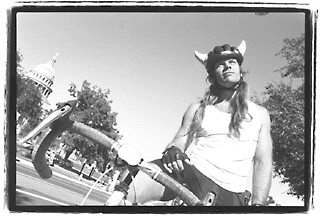
Eden agrees that the city's attitude toward cyclists still needs to improve. His "modest proposal" for a $600,000 ABP budget, which would represent 11% of the total city transportation budget, is based on the ATS' Austin Metropolitan Area Transportation Plan, which set a goal for city traffic to consist of at least 5% bicycle trips and 6% pedestrian trips. But the ABP did not receive any budget increase this year.
"They can spend millions on a single intersection, but if you ask for $600,000 for bicycles, they say, `No, that's too much,'" complains Eden.
The city has recently added a new planner to the ABP office (courtesy of a federal grant) to take over administration of certain projects, Waring says, which should speed things along. Still, he says, if the council could give just a little more money, the office needs a part-time person to handle the flow of citizen requests pouring in over the telephone.
Lastly, the ABP office is proposing that the city prohibit parking in bike lanes, though Waring says that if such an ordinance were passed, the ABP office would meet with neighborhood groups to work out compromise proposals that would be passed along to ATS for consideration in public hearings -- compromises might include clearing only one side of some streets, or enforcing the ordinance only during certain time periods.
In the meantime, some Austinites are joining the call to make biking a reality despite the hazards. Bobby Sledge, an engineer who works at the Pickle Research Campus, has been biking to work occasionally for two years. He says his ride is sometimes scary, since he has to cross the notorious barrier at Shoal Creek and 183, but Sledge says he is nonetheless committed to staying visible as a cyclist.
"My presence is important to improving the situation.... People are beginning to recognize that we have a right to be on the road even though we're an inconvenience to them." He regrets, however, that his friends won't ride to work because they feel in danger trying to traverse Burnet Road, a route Sledge says he rides "real fast." "I may be braver, or stupider, I don't know," says Sledge.
"The concept ought to be that you are traffic and you belong on the road," says Meredith. "Like it says on our new bumper stickers: `Same roads, same rights, same rules.'"
Got something to say on the subject? Send a letter to the editor.





